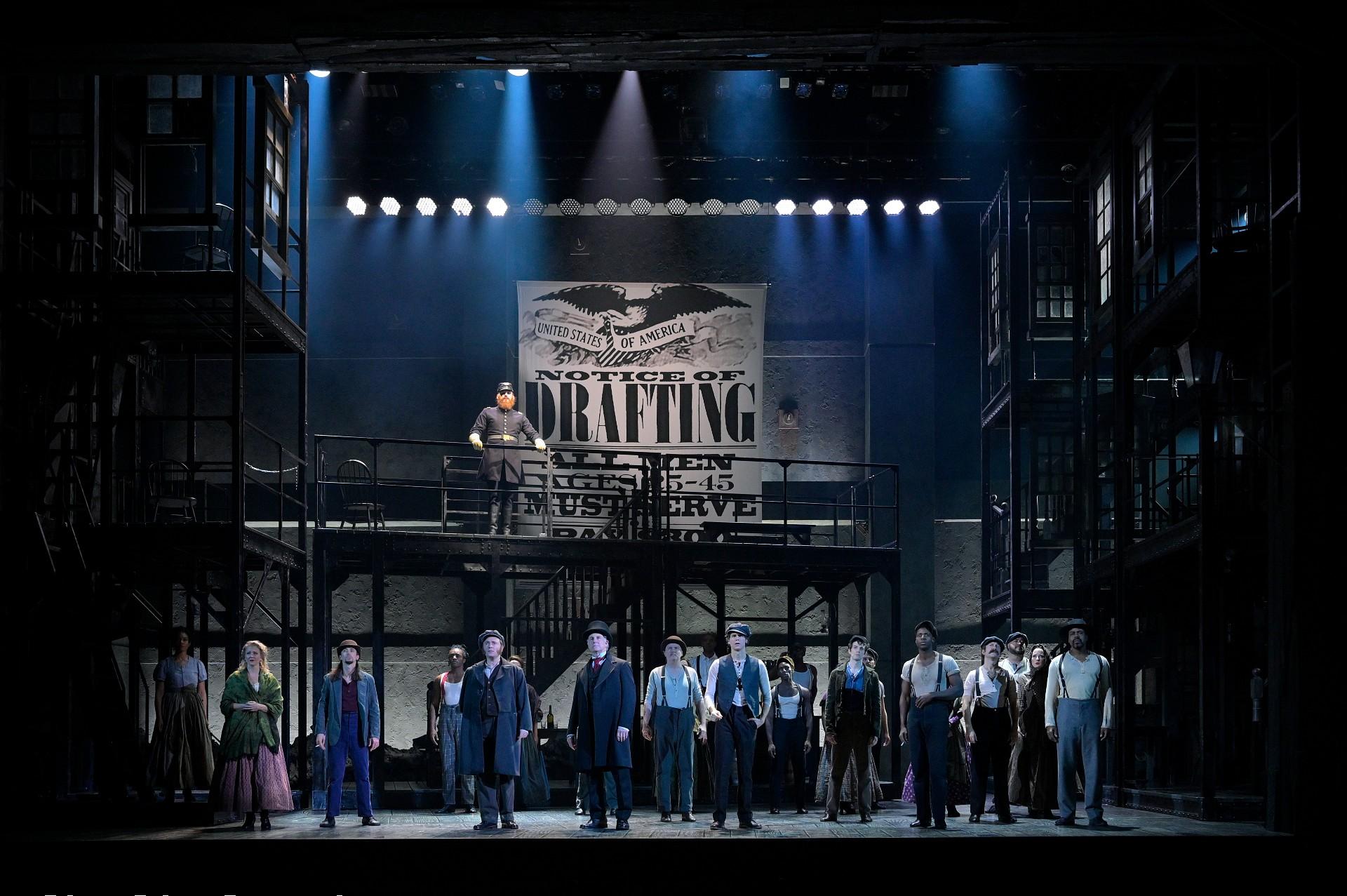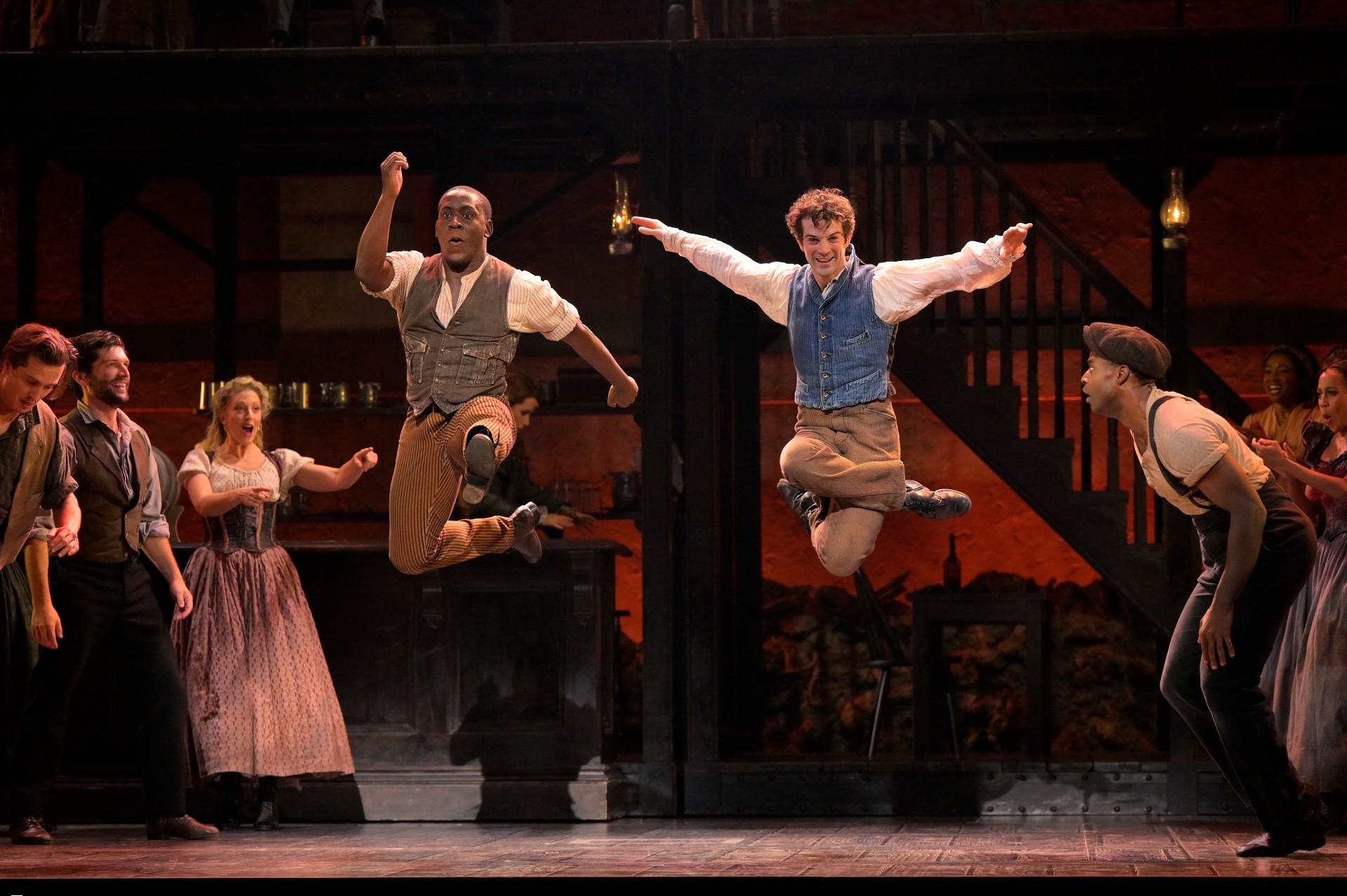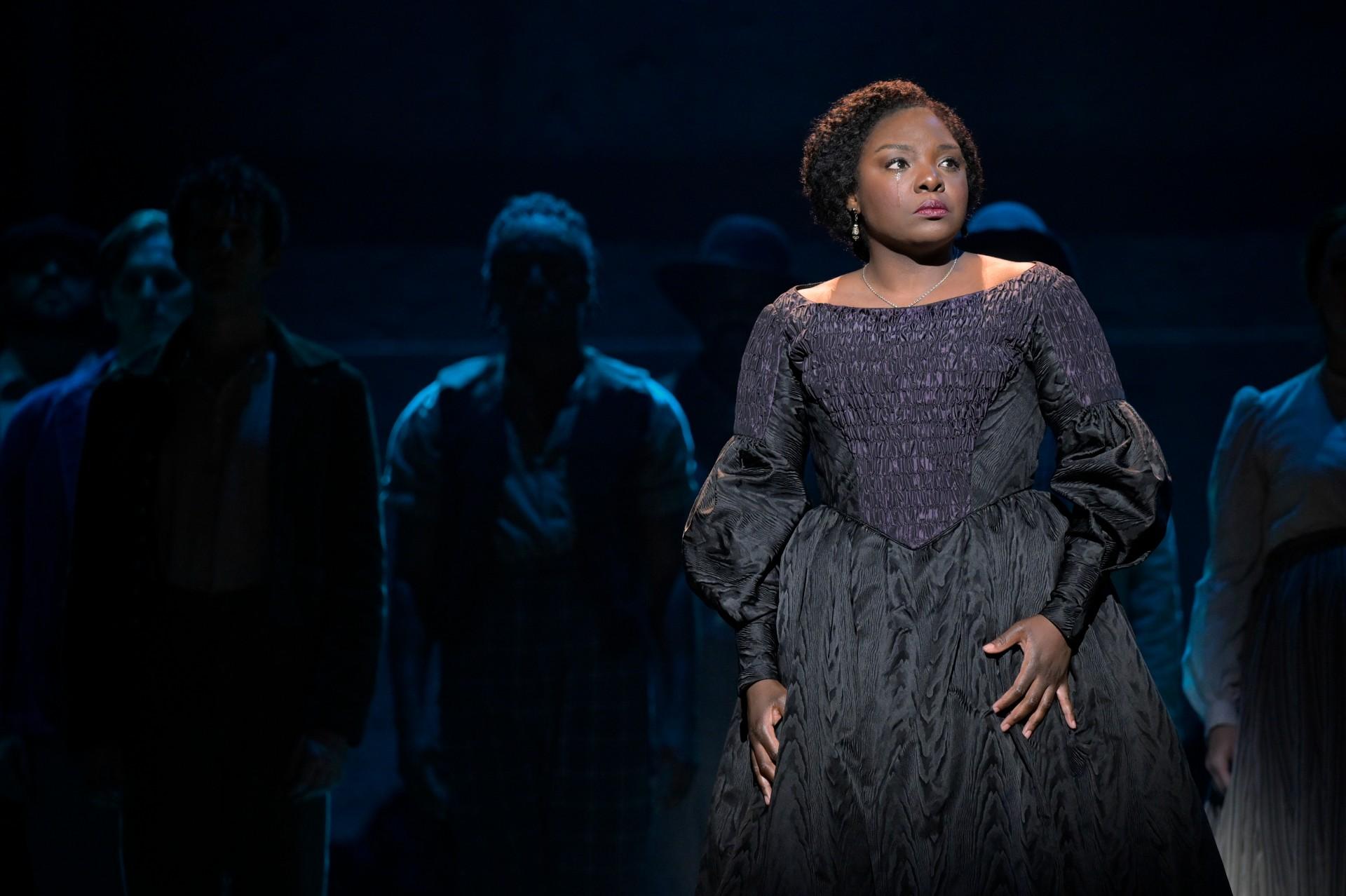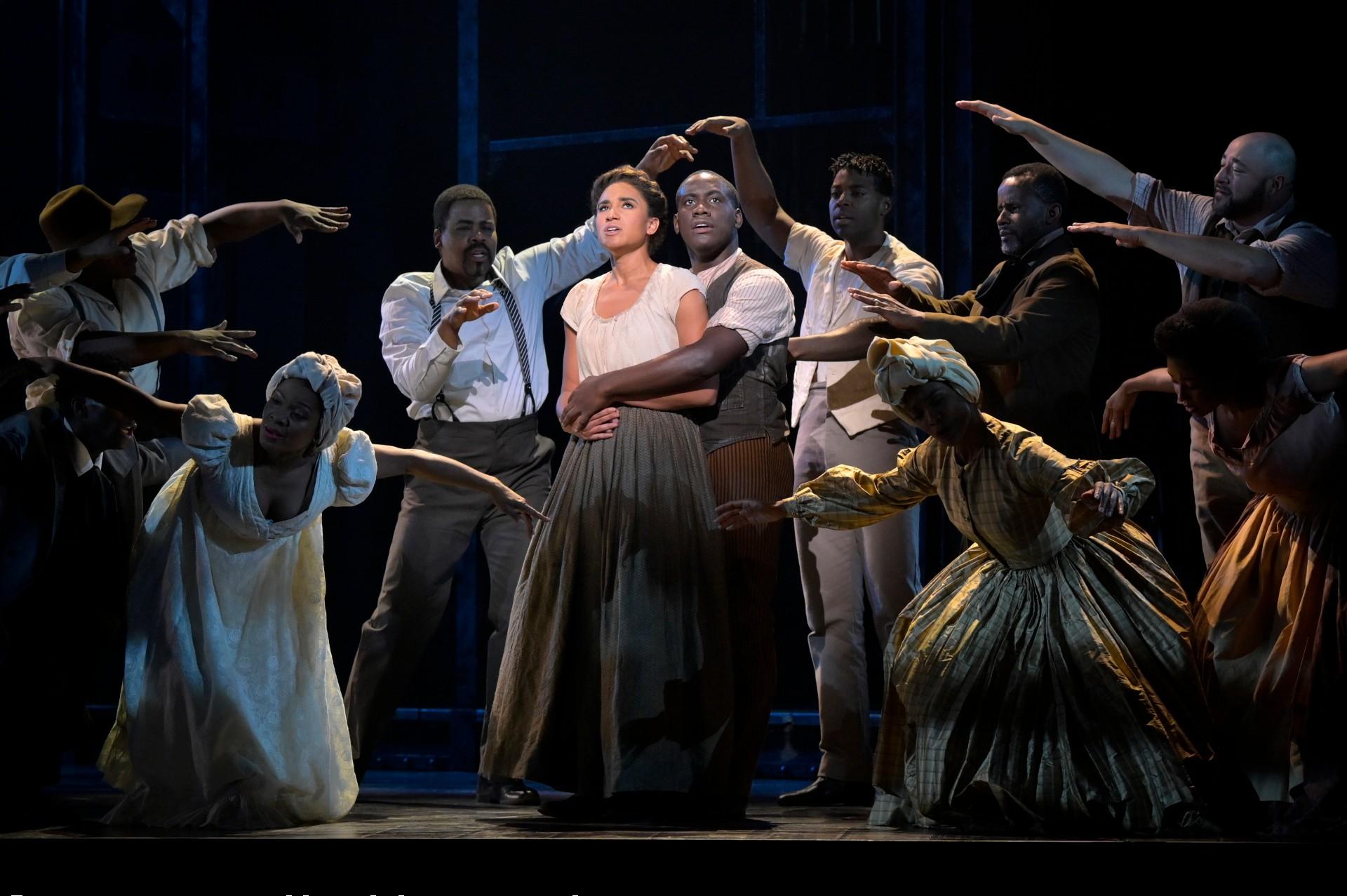Below: Nataniel Stampley, Sydney DuPont, Joaquina Vedric, AJ Shivry, Chirina Kennedy. Upper center: Erica Spyres, John Doset and Ensemble of “Paradise Square”. (© Kevin Berne)
It was the summer of 1863, in the midst of the Civil War. The location is in the Five Point district on the Lower East Side of Manhattan, a slam-dwelling where poor Irish migrants fleeing famine mix with free-born blacks and escape from plantations in the south but are still being tracked. .. .. But in that poverty and deprivation of rights, there is a saloon owned and operated by Nelly O’Brien, an indomitable black woman who married a white man who was not fighting in the Union Army.
Nelly’s saloon – in many ways anomalous – is called Paradise Square. And it welcomes both Irish and black people in the neighborhood. They can both dance the storm and in some cases get along. But with the fun spirit of bar competition and mutual support, of course, it’s short-lived. White men of the poor working class are suddenly exposed to drafts while black men are forbidden to serve in the Union Army. And the problems posed by fierce competition for work are manipulative white politics that serve a wealthy “uptown” crowd and intensify the highly devastating racial tensions that overturn the short moments of coexistence. Abused by the boss.
 Kevin Dennis, John Dosset (5th and 6th from the left), AJ Sivry (6th from the right), and the Ensemble of “Paradise Square” (© Kevin Berne)
Kevin Dennis, John Dosset (5th and 6th from the left), AJ Sivry (6th from the right), and the Ensemble of “Paradise Square” (© Kevin Berne)
And there is an essential element of the epic musical “Paradise Square” made possible by the cast of megawatt talent. Invented (and long-developed) by Rally Car One, the show arrived at the Nederlander Theater for a tryout in front of Broadway Chicago. In many respects, the broken nature of racing, class, and the American dream. (And it’s the creation of a completely different art team, but brought about by the same producer, Garth Drabinsky).
Directed by Moises Kaufman (a musical staging by Alex Sanchez), Jason Howland underpins the music with ardent (and now semi-opera-like) scores with burning lyrics by Nathan Taisen and Mashi Asare. It has been. The book by Christina Anderson, Marcus Gardley, Craig Lucas, and Kirwan can use some tightening.
What really blows the show out of the park is by Bill T. Jones, who is in many ways more powerful than spoken language because of its knockout dance and the incredible rhythms and movements of both the Irish stepdance and African Juba. It’s a wonderful choreography. In a brilliant competition that reveals the genius of both “languages”.
 Sydney DuPont as Washington Henry, AJ Sivry as Owen Duignan, and the “Paradise Square” ensemble (© Kevin Berne)
Sydney DuPont as Washington Henry, AJ Sivry as Owen Duignan, and the “Paradise Square” ensemble (© Kevin Berne)
Dance speaks of volume in every aspect of the show, but it’s time to emerge that drives historical events that inspire that important drama (and it may not be known at all). Too much. Simply put, blacks were not allowed to serve the Union Army until President Lincoln announced the Emancipation Proclamation in late July 1862 (he alienated the people of the “Border States” and dismissed them. I was afraid that it might be). Meanwhile, when white working-class men returning from the front lines were looking for jobs, they resented the fact that many of those jobs were given to black men. And New York politicians, hungry for Irish (and other) immigrant votes, further fueled their resentment by the 1863 Conscription Act, which allowed wealthier whites to get out of military service. I stir up. Fallout came in the form of a massive riot that claimed many lives and caused enormous destruction when it became known as the New York Conscription Riot. (The penultimate song of the show, “Let It Burn,” was far from a constructive healing solution to the country’s lasting problems, but nevertheless received a fierce standing ovation at Wednesday’s opening night performance. )
But now let’s move on to the characters in this story and the galvanic performances that lead them to a very vibrant life.
 Hoakina Whiskas as Nelly O’Brien in “Paradise Square”. (© Kevin Berne)
Hoakina Whiskas as Nelly O’Brien in “Paradise Square”. (© Kevin Berne)
Joaquina Kalukango plays Nelly O’Brien with a powerful voice and a comparable personality. On the one hand, she can provide shelter for desperate people, and on the other hand, she can confront corrupt forces without fear. Calcango is a force to consider in every respect.
And in the story, there are two crucial young men who dance a wonderful storm of competition and are extraordinary actors and singers. AJ Sivry plays Owen Duignan, a newly arrived Irish immigrant (and provides a transcendental performance of the tragic song “Why should I die in the spring?”). Sydney DuPont plays Washington Henry, a runaway slave from Tennessee, bringing deep despair to “Angerina Baker.” It’s a song about his deep fear that his beloved wife (played by Gabriel McLington) may not be able to go to New York. His dance is astounding.
Nathaniel Stampley, a Chicago-based actor, takes on the role of Rev. Samuel Jacob Lewis, a black man who married Nelly’s white business partner Annie Lewis, in his quiet authority, dignity, and dignity. Brings an amazing understated aura. I also work as a foreman and have to make very difficult hiring decisions. Annie (played by witty, golden voice Chirina Kennedy) has won the couple’s ironic title song “Gentle Annie”. (Nelly and Annie have a memorable bond with the beautiful song “Someone to Love”.)
The show’s “real” character is Stephen Foster (Jacob Fissell), the legendary American composer of the Minstrel song. pianist.
 Gabrielle McClinton, Central, Angelina Baker, Sydney DuPont, Washington Henry, Ensemble “Paradise Square”. (© Kevin Berne)
Gabrielle McClinton, Central, Angelina Baker, Sydney DuPont, Washington Henry, Ensemble “Paradise Square”. (© Kevin Berne)
John Dosset is a chilly, abolitionist for the role of New York political boss Frederick Tigens, who stirs up the deadly racial turmoil that puts an end to the short-lived racial Eden proposed by Paradise Square Saloon. Brings the arrogance of the theorists. And there is a strong shift by Union victims Kevin Dennis and Matt Bogart.
Allen Moyer’s steel-like set and bar interiors, with lighting by Donald Holder and costumes by Tony Leslie James, added to the mood.
But, again, it is in many ways dance that captures the connection and disconnection of this story most brilliantly and eloquently.
By the end of “Paradise Square”, you may be wondering if there are some musicals that offer “Paradise Square” and “Ragtime” epilogues. Oddly enough, “hair” may fill the space of the 1960s, but the stories set around 2020 and 2021 haven’t been created yet.
“Paradise Square” will be held at Nederlander Theater, 24 W. Randolph St. until December 5th. For tickets, please visit the following website. Broadwayinchicago.com.. The show will be held on Broadway on March 20th and the preview will start on February 22nd.
Note: Next up via Chicago’s Broadway are numerous shows, including “Frozen.” “Pretty Woman: Musical”; “Play that doesn’t work”; “Oklahoma!”; “Hairspray”; “Come away”; “Simon & Garfunkel Story”; “Moulin Rouge! Musical”; “Hadestown”; “Six “;” Prom “;” Jersey Boys “;” Kill Mockingbird “;” Fiddler on the Roof “;” I’m Not Proud-The Life and Age of Temptation “;” The Woman I Love “;” Jesus Christ Super “Star”; and “The devil is wearing Prada.”
Follow Hedy Weiss on Twitter: @HedyWeissCritic
“Paradise Square” dances violently and timely to racial uprisings during the Civil War | Chicago News
Source link “Paradise Square” dances violently and timely to racial uprisings during the Civil War | Chicago News
The post “Paradise Square” dances violently and timely to racial uprisings during the Civil War | Chicago News appeared first on Illinois News Today.


No comments:
Post a Comment